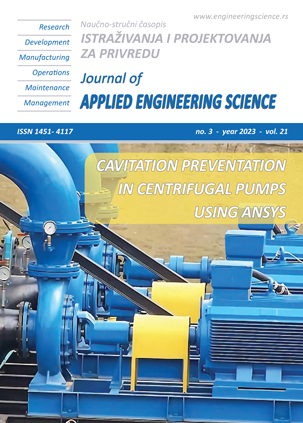THE FLEXURAL BEHAVIOR OF HOLLOW CORE CONCRETE SLABS WITH DIFFERENT SHAPE
Abstract
Hollow slabs are slabs of reinforced concrete in which voids allow the concrete to be reduced in size. This type of slab results in reduced raw materials Consumption and increased insulating properties to achieve sustainability goals. This paper reported an experimental research program focused on the study of the bending behaviour of the elements of hollow slabs of normal-strength concrete. Three models of the one-way concrete slab were cast, It had dimensions of 1020 mm length, 420 mm width, and 100 mm thickness. The first model did not contain holes (solid) and the second model contained five circler opening holes with a 50 mm diameter, while the third model contained five square opening holes with 44 mm dimension, where the area of the second and third model were the same despite the difference in the shape of the opening. The results showed that the bearing capacity of the circular hollow core slab is higher by 12% compared to the square hollow core slab according to the type of voids and both of holes made the hollow core slab with a decrease in load capacity of 11% to 25% when compared to the solid slab. The solid slab has lower deflection value compared to the two hollow slabs whose weight is reduced by 23% compared to the solid slab.
References
[1] Mhalhal J. M., (2017), Prestressed precast hollow-core slabs with different shear span to effective depth ratio, Wasit Journal of Engineering Sciences, vol. 5, no. 2, 1–11, DOI: https://doi.org/10.31185/ejuow.
[2] Monisha K.M. and Srinivasan G., (2017), Experimental behaviour of prestress hollow core slab, RC hollow core slab and normal RC solid slab, International Research Journal of Engineering and Technology, Vol. 04, Issue: 04, 1090-1093.
[3] Mones, Ryan M., and Sergio F. Breña. (2013), Hollow-core slabs with cast-in-place concrete toppings: A study of interfacial shear strength", PCI Journal 58, no. 3 , 124–141.
[4] Stephen, C. (2013), Hollow core manufacture and factory design, The Indian Concrete Journal.
[5] Xu X., Yu J., Wang S., and Wang J. (2014): Research and application of active hollow core slabs in building systems for utilizing low energy sources, Applied Energy , 424–435.
[6] Shawel, A., (2008), Compression of prestressed hollow core slab and precast concrete beam-HCB slab system", M.Sc. Thesis, Addis Ababa University, March.
[7] Chung, J.H., Choi, H.K., Lee, S.C. and Choi, C.S., (2011), Flexural capacities of two-way hollow slab with donut type void. Proceeding of annual conference of the architectural institute of Korea, pp9-20.
[8] Salman, W. D., (2012), Flexural behavior of bubbled reinforced concrete slabs", Ph.D. Thesis, University of Baghdad.
[9] Mutashar, S. H., (2017), Flexural behavior of sustainable reactive powder concrete voided slabs", M.Sc. Thesis, Al-Mustansiriayah University, May.
[10] ACI-318 (2014) Building Code Requirements for Structural Concrete (ACI 318S-14) and Commentary (ACI 318SR-14), ACI 318-14.

